Assistance Dogs
LINJOR is proud to be associated with Dogs for the Disabled, Hearing Dogs, and Cancer Detection dogs, using puppies bred by us for there temperament, intelligence and adaptability.
Puppy Power
Ever wondered how Dogs for the Disabled select the breeds or the puppies that come into the scheme? Newshound has tracked down the answers by taking a trip to Wales with Rob Harris, who has been tasked with finding new recruits for the charity. Here is an insight into the world of all things puppy.
Selecting the puppies to become a potential assistance dog would be many people's dream job. Going to visit litters of pups all around the country does seem to be the ideal for many dog lovers, but we find on our trip to Wales that it's not just all about the pup, it's in the genes too.
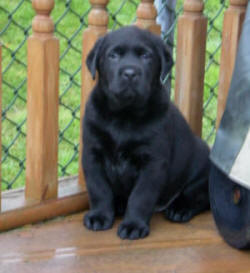
CODENAME LINJOR
What I aim to do in my role is to look at finding breeders who are breeding puppies that fit our purpose." Rob Harris, Dog Selection Co-ordinator. "That is aiming to select dogs from breeding lines that should have the temperament and health we are looking for as an assistance dog."
"Over the years, the charity has been able to identify that Labrador and Golden Retrievers have the traits and character that best suit our clients. For one, they are a good size for a client who maybe wheelchair bound, to receive something that might have dropped from their dog. Secondly, the two breeds have a natural ability to retrieve, one of the key elements of the task work the dogs undertake daily for their partners. And of course, they have the temperament for being with people, they are very social dogs."
"What we ideally are looking for is a dog that is calm, confident and enjoys working. They need to be adaptable as well, so they can go from doing quite a lot of work for their partner one minute, and then be able to lie down quietly in a cafe, the next."
"The other key feature is that we try and select dogs that come from parents that have good health. We measure health through selection of puppies that both parents have been tested for hereditary conditions such as cataracts and hip dysplasia (where a dog may suffer arthritis in their hips). We only source puppies from parents with the correct health certification. This is not an exact science, as genes that cause these conditions can skip a generation or two, but it's a best start."
RAINCLOUD
"Since I started working for the charity, I've been working to develop contacts with breeders so that they can let me know when they are going to be breeding a litter. We have been able to source some cracking puppies for the scheme. We are also establishing stronger links with rescue centres and breed rescue societies who may also be able to identify puppies or young dogs that would fit our criteria. From time to time I also go and visit people who want to donate a puppy to the charity. Again, we make sure that we still use our criteria when selecting a dog, even if they are a donation, as it would be a bad outcome all round if we were to train a dog that later had to be withdrawn due to poor health."
"Today, we are going to meet Linda Harvey-Major at her home in Cwmavon, Wales. Linda has been breeding and showing Labradors for over 36 years, so she knows a thing or two about her dogs! Linda has two pups from a litter who are now about nine weeks old - potentially we could be bringing one back with us."
"On our journey to Cwmavon, Rob explains how he will assess the two pups. “What I like to do is to go into the puppies' kennel or in the room where they sleep to see how they interact with one another. I'm looking at their social and exploration skills, to see if one is more independent than the others. I’ll sit on the floor with the pups and let them crawl all over me. It’s all part of the assessment to see how confident they are with new people who have different voices and smells too.”
One of the pups has been sold, so Rob now has to assess the remaining puppy to see if he fits our criteria. Although he is the last puppy left, Rob will not select the pup unless he is right for the charity’s needs.
Firstly, Rob observes the two siblings at play. Although it’s a fairly hot day, they enjoy running around playing with their toys. Rob then brings out the Frisbee and see’s how the pups take to the new object. It’s a tussle to see which pup can get their first – no problem; both puppies think their new play thing is great fun.
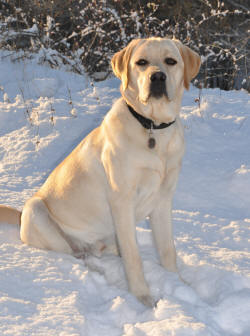
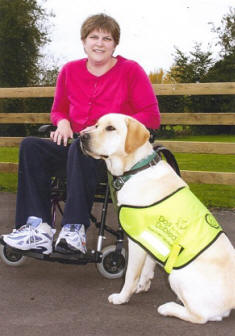
JAMES WORKING WITH HIS NEW DISABLED PARTNER
Now it’s time to access the dog puppy, called James, on his own. Linda picks up James’s sister so there are no distractions. Rob tests James with the treats, he is keen to investigate Rob’s fist, smelling the bag of food he has in his palm. James tries to open Rob’s fingers using his paw and teeth.....
Although he is mouthing Rob’s fingers, he doesn’t bite hard. James has now realised that Rob has something interesting in his other hand and attempts to open Rob’s right hand where the small amount of treats are held. Rob rewards this behaviour and repeats the exercise a couple of more times. James quickly works out that although the bag of food smells stronger he is only able to get rewarded for the smaller amount. This shows that James is able to assess the situation and change track to get the treat award.
For the final part of the assessment, Rob lifts James into his lap and gently places him on his back. He’s assessing how much of a struggle James makes to try and turn over – but the pup is pretty content to lie quietly and have his tummy rubbed – it’s a hard life. Rob is happy with the assessment and asks Linda if it’s okay for us to take James back home with us. So after a quick drink and all the paperwork completed, its back to HQ in Banbury for the team with James safely aboard.
Once we arrive back at the centre, James gets his first chance to take in the sights and sounds of the charity’s head quarters. With approximately 30 dogs in training at any one time, it certainly has its own characteristics. James seems to take it all in his stride.

LINJOR CHOKOLADEN (CINDERS)
“Next, I’ll ask for the other puppies to be taken away just leaving me with one pup so I can make an assessment without any helpers! I have a backpack of toys and treats with me which I’ll use to test how they react to new situations. For example, I might use a soft Frisbee to see what they think of a something they might not have seen or felt before. What I’m looking for is one, how the puppy reacts and two, if they are cautious of the new object, how long it takes them to get over their fear and check out the new toy – this is what we call recovery. The ability to recover quickly is vital for an assistance dog, as they will be going in to new places with their partner and they need to be able to cope and adapt to new stimulus, which can even just be new smells.”
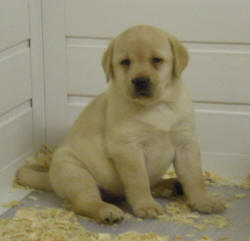
LINJOR PROMISE (BRIGGS)
“Then I’ll get out a small packet of treats and put one or two in my hand. What I’m looking for here is how interested the puppy is in finding out about the treat – how hard they try and get my fingers to part so they can have the treat – we call this drive. I’ll place the bag of treats in my other fist and again, see if the puppy uses his brain to check out the other hand to see if he can get any joy with this one. This will display the puppies ability to problem solve, when he finds he can only retrieve the couple of treats instead of a large bag. I’ll also be assessing the levels of frustration displayed.”
“All these tests just give me a guide. I want a puppy that responds well, is friendly but not over confident or bolshie but at the same time, they don’t want to be too timid.” We arrive at Linda’s home. After initial hellos, it’s down to business – playing with the pups! Linda takes us to her block of kennels where some of her show dogs live. Two puppies are left from the litter – the mother of this litter is also the mother of Linda’s Top stud dog.
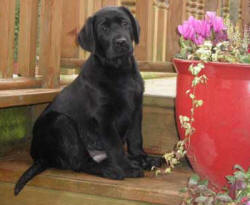
LINJOR BRISK WINDS (BESSIE)
"CINDERS"
SUCCESSFULLY COMPLETED HER 16 WEEKS EARLY TRAINING PHASE - GOOD AT TASK WORK, CAN RETRIEVER, POST, MOBILE, KEYS ETC. AND PUSH AND PULL JUST AS GOOD - CAN PUSH BUTTONS AT PEDESTRIAN CROSSINGS, AND DOOR BUTTONS, BANKS AND PUBLIC BUILDINGS, CAN OPEN DOORS, PULL DOWN ZIPS AND PULL OFF GLOVES AND SOCKS, EVEN OPENS DRAWS.
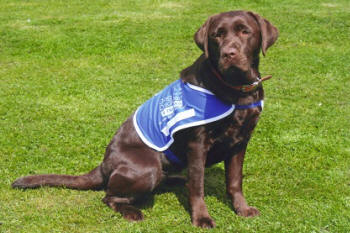
CINDERS HS GOOD OBEDIENCE , SHE HAS GOOD RECALL,SHE SITS AND WAITS NEXT TO A WHEELCHAIR WITH HER LEAD IN HER MOUTH, SHE CAN WALK ALONGSIDE AN ELECTRONIC WHEELCHAIR AS WELL AS DOING TASK WORK. VIKKI MARK.
"Cinders" has now become a fully trained assistance dog and is seen with her new owner here Anne Edwards
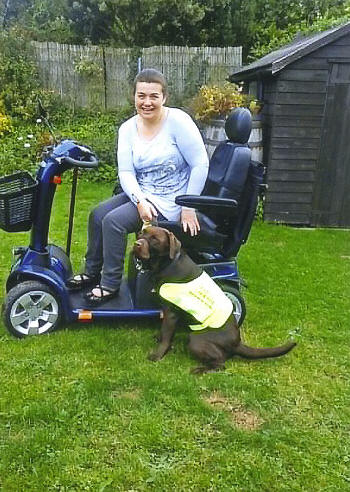
"BESSIE"
PASSED HER 20 WEEK ASSESMENT, AND HAS MOVED ON TO ADVANCED TRAINING., SOO TO BE MATCHED AND PARTNERED WITH HER NEW FAMILY.
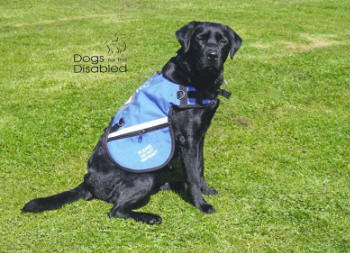
BESSIE HAS CONSOLIDATED HER LEARNING, CAN MAINTAIN A STRAIGHT POSITION AND SEEK KERB STOPS IN DIFFERENT ENVIRONMENTS, SHEE IS VERY RESPOBNSIVE, ABLE TO COPE WITH A VARIETY OF DISTRACTIONS AND FOCUS ON HER "ROLE". SHE WILL REST HER NOSE ON A CHILDS LAP AND TOUCH HER NOSE ON THEIR LEG WHEN ASKED. SHE HAS BEEN VERY ENTERTAINING AND A PLEASURE TO TRAIN. HELEN BRONTI.
Our Ref: VM/Update
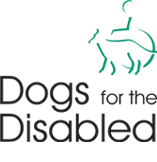
07th December 2009
Mrs Linda Harvey-Major
Reservoir House
Cwmavon
Torfaen,
NP4 9DZ
Dear Linda. He has even learnt that when he can't
reach my hand it is easier to step up onto my lap to give the
article to me, which he loves as he knows he is going to get a
cuddle!
Pull and Push work is very good. Cloud can easily pull open
doors and drawers and pull zips, gloves and socks. He also
pushes buttons including pedestrian crossings and door buzzers i.e.
Banks/Public Buildings etc which he absolutely loves to do.
Cloud can walk through town alongside an electric wheelchair as
well as doing task work. He also loves to free run in the woods
and has very good recall. He has also found that it is very fun
to empty out the washing machine as you never know what you are
going to find there!
Cloud will commence advanced training on 6th January, with
Louise Hart our northern based instructor. I will pass all of
your details onto Louise so she can keep you updated of his
progress during advanced training.
In the meantime, thank you once again for Cloud. He really is a
lovely little boy and I will miss working with him once he goes
on to advanced training. He is a credit to you. I have enclosed
a photo of him looking very smart in his training jacket.
With the very best wishes
Vicki Mark
Trainer
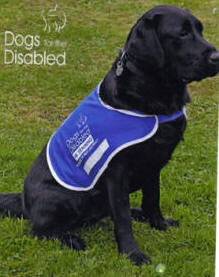
LINJOR RAINCLOUD (CLOUD)
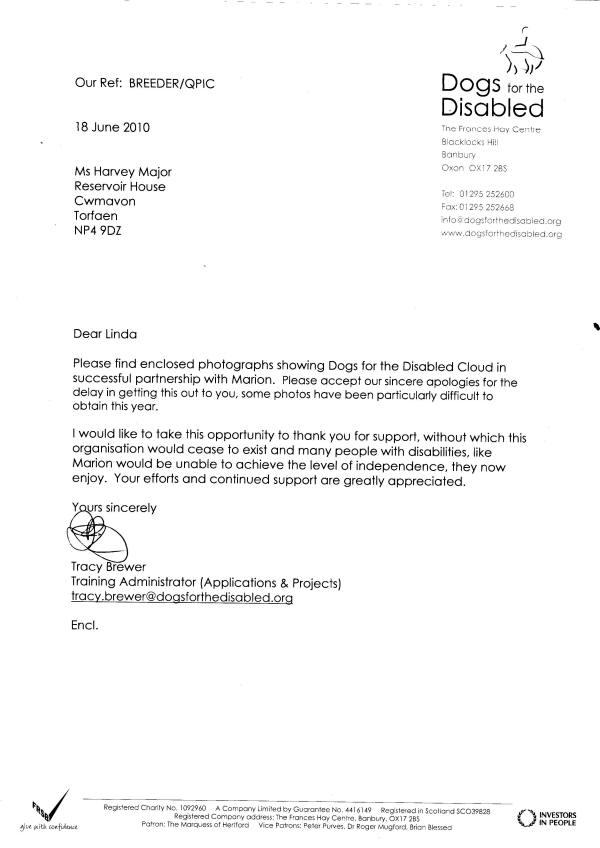
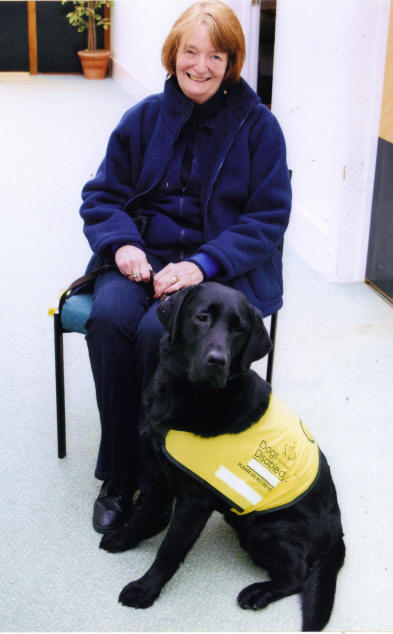
Cloud and Marion
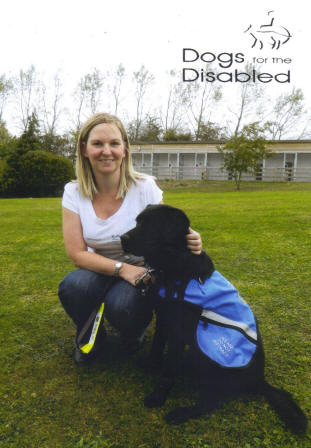
BESSIE WITH HER NEW OWNER DEBORAH BURD
Bessie qualified in December 2011
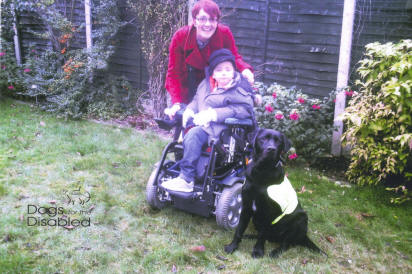
CODY WITH HIS NEW OWNER JOEL HALES-WALLER
Cody qualified in December 2011
LINJOR CASEY
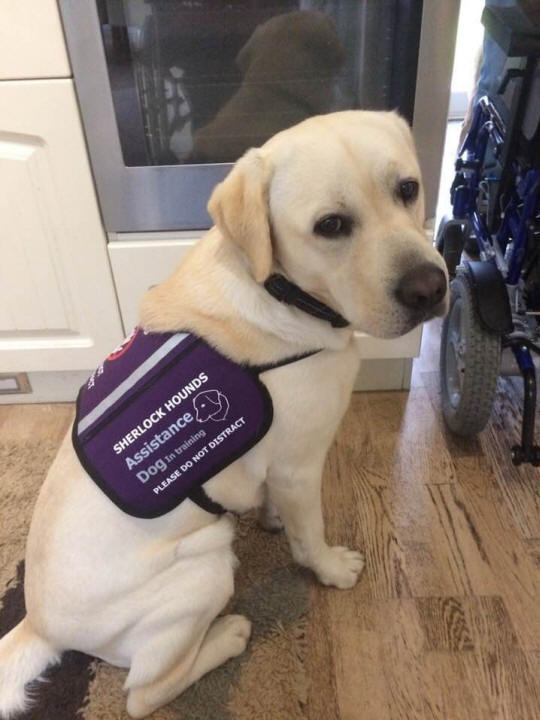
Casey is an owner handler Trained dog with Tracey Dolan and she is a member of
http://www.sherlockhounds.org.uk/
Tracey is in a wheel chair and has limited use of her hands and Casey helps her with everyday things, he has been trained to a high standard and has specialist training and experience
Well done Tracey, I know he has a lovely home with you.

